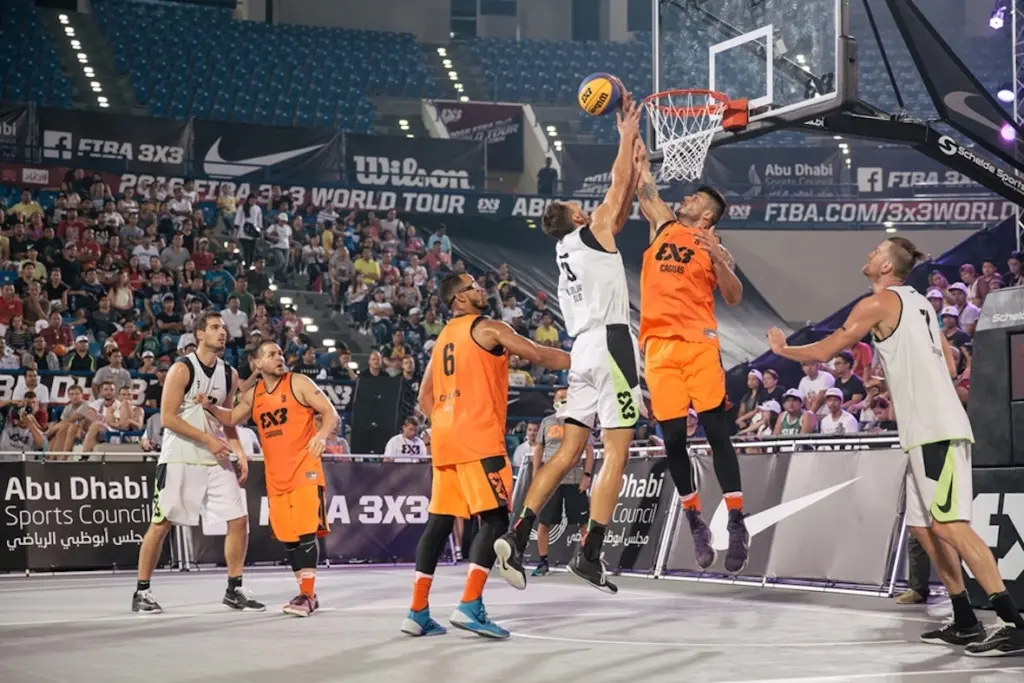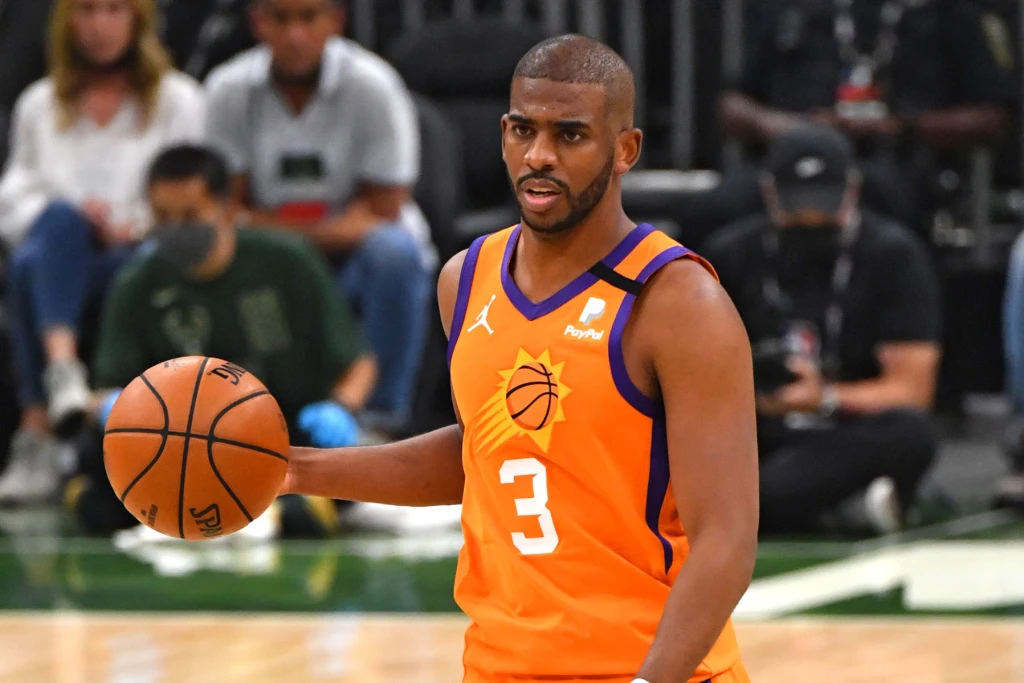In a typical basketball game, each team has five players on the court.
But, how many players are on a basketball team in total? (i.e. including substitutes, inactive players, etc.)?
The answer varies depending on which league the team is playing in.
Here is a quick overview:
| League | # of Players on team |
|---|---|
| NBA | 15 |
| G League | 12-13 |
| FIBA | 12 |
| FIBA 3×3 | 4 |
| WNBA | 12 |
| NCAA | 15 |
| High School | (varies by state) |
Keep reading for a more detailed breakdown of each league’s team size rules.
I also take a quick look at some other interesting roster rules, and the positions on a basketball team.
Let’s get started!
NBA teams: 15 players

The NBA is the most popular basketball league in the world, and also has the most confusing rules when it comes to roster sizing.
In general, an NBA team has a maximum of 15 players on its roster during the season (not including Two-Way players). Each roster is made up of:
- Active List – These players are allowed to participate in games
- Inactive List – These players are not allowed to participate in games
According to the official NBA-NBPA Collective Bargaining Agreement (CBA), here are the rules. I have tried my best to summarize things nicely:
Active Roster
During the regular season, an NBA team must have 12 or 13 players on its “Active List”, and at least 8 players suited up for every game.
A team is allowed to reduce its Active List down to 11 players for up to two consecutive weeks if there are special circumstances like players being waived, etc.
After a team’s last game of the season, they can have a maximum of 20 players on their active list (including G League two-way players). Players from a team’s “Inactive List” are automatically transferred to the “Active List” after the last game of the season.
Before the next season starts, a team must reduce the number of players on its Active List back to 13.
Inactive Roster
An NBA team must have at least 2 players on its “Inactive List” for all regular season games.
Depending on special situations, this number can be reduced to 1 or 0 for a maximum of two consecutive weeks.
For example, if a team only has 11 or 12 players on its Active List, they are allowed to reduce the Inactive list to 1 player.
If a team has 13 players on its Active list, they may reduce the inactive list to 0 players for a limited time.
If a Two-Way player is added to the Active or Inactive List, then the minimum number of Inactive players must increase by one.
Two-Way Players
Each NBA team can have two “Two-Way” contract players. These players play most of the season in the G League, and up to 50 games in the NBA.
If a Two-Way player is called up the NBA team, then they are included in the teams Active or Inactive List.
A Two-Way player is not eligible to play in the playoffs, unless signed to a new contract.
Playoffs
For the playoffs, if a team has 12 players on its Active List, they can have 3 players on its Inactive List. If a team has 13 players on its Active List, they can have 2 players on its Inactive List.
G League: 10-13 players

G League rosters fluctuate constantly due to call ups from affiliate NBA teams. According to the official G League website, here are the rules:
There are a minimum of 10 players on rosters, not including a pair of two-way players allowed per NBA team. A team’s active roster may expand to up to 13 players if its parent club assigns players from the NBA roster.
FIBA: 12 players

FIBA has much more straightforward rules compared to the NBA.
Each team consists of a maximum of 12 players.
That’s it!
FIBA 3×3: 4 players

For FIBA’s official 3-on-3 games, each team can have a maximum of 4 players (3 players on the court, plus 1 substitute).
WNBA: 12 players
The WNBA also have straightforward roster rules.
Each team can have a maximum of 12 players.
Many WNBA teams actually carry less players, so they can pay their star players more.
NCAA Basketball: 15 players

NCAA college basketball teams can have up to 15 players on its roster (i.e. squad size).
They can have more players on the team, but only 15 are allowed to compete. Many teams do not actually carry the maximum number of players.
High School: varies

High school basketball team sizes vary depending on where you play.
For example, the Minnesota State High School League allows a maximum of 18 players (that dress for the game). Washington State only allows 12 players.
Typically, high school teams will have around 10-15 players.
The only set rule is that teams must have 5 players on the floor to start the game.
I remember my team had 12 players. It became 11 after one guy quit, and we never added anyone else.
The 5 Basketball Positions in a Team
There are traditionally five positions on a basketball team:
- Point guard
- Shooting guard
- Small forward
- Power forward
- Center
Basketball has become more and more “positionless” over the years with players blending between multiple roles, but the traditional positions still play an important part in the game.
Here is a quick breakdown of each:
1. Point Guard (PG)

The point guard position is also known as the “1”.
Traditionally, the point guard is the main ball handler and decision maker of the team. He/she is responsible for bringing the ball up the floor, initiating plays, distributing the ball to teammates, and controlling the pace of the game.
These days, there are a lot more “scoring point guards” who focus on scoring/shooting as much as they do on passing.
Some top point guards currently in the NBA include Chris Paul, Steph Curry, Luka Doncic, and Damian Lillard.
2. Shooting Guard (SG)

The shooting guard is also known as the “2”.
The SG is typically responsible for perimeter shooting/scoring and attacking from the outside. They are also the secondary ball handler after the point guard.
Some of the top shooting guards currently in the NBA include Devin Booker, Zach Lavine, and Jimmy Butler.
3. Small Forward (SF)

The small forward is also known as the “3”.
The SF is usually a very versatile player that can play inside or outside. He/she is responsible for doing a bit of everything, including scoring, playmaking, and rebounding.
Some of the top small forwards in the NBA include Kevin Durant, LeBron James, and Jayson Tatum.
4. Power Forward (PF)

The power forward is also known as the “4”.
The PF is traditionally a bigger player that focuses on rebounding and scoring inside or around the paint. These days, many PFs also shoot threes and score from the outside.
Some of the top power forwards currently in the NBA include Giannis Antetokounmpo, Anthony Davis, and Julius Randle.
5. Center (C)

The center is also known as the “5”.
The center is typically the biggest/tallest player on the team. He/she is responsible for scoring inside, defending the paint, blocking shots, and getting rebounds.
Similar to PFs, many centers these days are also scoring from the outside, and playing from the perimeter (to the dismay of traditional big men everywhere).
Some of the top centers in the NBA include Nikola Jokic, Joel Embiid, and Jonas Valanciunas.
Frequently Asked Questions
How many players are there in NBA?
There are approximately 450 players in the NBA.
This number includes both active and inactive players. The actual amount fluctuates throughout the season as players are waived or signed.
If you include G League Two Way and affiliate players, then there are around 500 players.
At most, there is a maximum of 390 active players at one time in the NBA (i.e. 13 per team).
Click here for a list of players for the current season.
How many players suit up for an NBA game?
An NBA team must have a minimum of 8 payers suit up for each game. The maximum number of players that can suit up is 13.
How many players are allowed on the court for each team?
5 players are allowed on the court for each team.
Can an NBA team play with 4 players?
No. According to the official NBA rule book (Rule No. 3, Section 1), no team may be reduced to less than five players.
If there are only 5 players remaining, and one gets injured or ejected, he will be replaced by the last player who fouled out.
Summary
Now you know how many players are on a basketball team (including substitutes) for the NBA, G League, WNBA, FIBA, NCAA, and more.
What do you think about the rules? Should the NBA or WNBA increase its roster sizes?
Leave your thoughts in the comments below!




